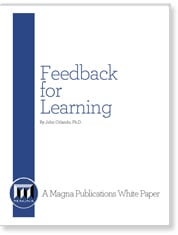Take a moment right now to ask yourself who your best teachers were growing up. Now list the qualities that made them your best teachers.
Read more ›CURRENT ARTICLE • March 27
OTHER RECENT ARTICLES
“The faculty of voluntarily bringing back a wandering attention, over and over again, is the very root of judgment, character, and will. No one is master of himself if he have it not. An education which should improve this faculty would be the education par excellence. But it is easier to define this ideal than to give practical directions for bringing it about.”
William James, (1842 – 1910)
Psychologist, Philosopher
Looking out at our students in classrooms today, with their texting, Facebook updates, Instagram messages, e-mail checking, Google searches, and tweeting, it’s hard to imagine what was so distracting for college students more than 100 years ago when James made this statement. Yet, even then, he recognized the propensity of the mind to constantly seek novel material, to leap from thought to image to belief to fear to desire to judgment and back again — all following one’s own quirky train of thought resembling the chaotic movements of a swarm of bees around a hive. Time passes through a warped dimension when the student finally returns to some semblance of attention, unaware of all the cognitive detours taken between points A and B. And that’s just the internal process, prompted by nothing in particular. How much more distraction is invited by today’s mobile technology?
When the term, “multitasking” first emerged, it was worn as a proud badge of accomplishment, touted as proof of the time-saving, productive, and therefore efficient executive. Now, research consistently shows that multitasking is not associated with peak performance; in fact, the opposite is true. More insidiously, multitasking is like drunk driving. Engaging in it impairs performance while simultaneously giving one the impression that functioning is unaffected or even improved. Furthermore, since the brain can only do one thing at a time, what is experienced as multitasking is actually “rapid task switching,” a challenge for the brain that actually compromises learning (Parry, 2013).
Contemplative Pedagogy
In her groundbreaking books, Mindfulness (1989) and The Power of Mindful Learning (1997), Harvard psychologist Ellen Langer lays the foundation for contemplative pedagogy, an educational model that seeks to cultivate deepened awareness and insight through introspection and mindful self-reflection. Teaching methods of inquiry such as journaling, guided meditation, conscious breathing, silence, and drawing stimulate deeper understanding of the material leading to a more personally meaningful experience of education. According to Tobin Hart, professor of psychology at the University of West Georgia, “Inviting the contemplative simply includes the natural human capacity for knowing through silence, looking inward, pondering deeply, beholding… What we know of learning is that the predominant factor is not merely time on task; it is the quality of attention brought to that task. If our attention is somewhere else, we may have little capacity to be present (Hart, 2004).”
Defining Mindfulness
Jon Kabat-Zinn, the founder of Mindfulness Based Stress Reduction (MBSR) defines mindfulness as “the awareness that emerges through paying attention on purpose, in the present moment, and nonjudgmentally, to the unfolding of experience, moment by moment” (Kabat-Zinn, 2003). Mindfulness meditation is a formal practice that involves regular meditation, intentionally re-focusing on the breath, or some other “anchor,” as one observes and retrieves the wanderings of the mind. Informal mindfulness is the daily intention to apply awareness to everyday activities without attachment or judgment.
At least two decades of neuroscientific and psychological research with adults has confirmed the benefits of mindfulness practices in improving such cognitive processes as working memory, attention, problem solving, and verbal reasoning (Chan, et al, 2008). Just 10 minutes of mindfulness each day has been shown to alleviate stress, boost immunity, decrease pain, lessen anxiety, decrease insomnia, and improve creativity (Schoeberlein David, 2009).
Meditation in the Classroom?
No, not necessarily… but some do. Mindfulness in education, and a great deal of validating research, has been around for several years, particularly in K-12 settings. Research confirms the myriad of benefits to both students and teachers (Poulin et al, 2008; Soloway, et al, 2011). In her book, Mindful Teaching and Teaching Mindfulness (2009), Deborah Schoeberlein David lists the following benefits of mindfulness practices in the classroom:
Benefits for teachers:
- Improved focus and awareness
- Increased responsiveness to student needs
- Enhanced classroom climate
- Improved overall well-being, emotional balance, and stress management
Benefits for students:
- Improved "readiness to learn"
- Strengthened attention and concentration
- Reduced anxiety before testing
- Increased self-reflection and self-calming
Mindfulness: Hitting its Stride in Higher Education
Many colleges and universities throughout the United States have established mindfulness programs and centers on their campuses. They host student mindfulness groups, and conduct workshops for students, faculty, and staff. Many have dedicated silent drop-in spaces for quiet pauses during the day. At these and other campuses, faculty have begun their own mindfulness practices and incorporate both direct and nuanced teaching methods in their classrooms.
You don’t need to be a seasoned meditator and you don’t need special training to get started incorporating mindfulness practices in your classroom. In fact, you don’t even need to teach a mindfulness module to your students, although that would be preferred. Learn some of the basic concepts, maybe complete some training, and then spend a few minutes introducing the concept to your class.
Find ways to illustrate and model focused attention:
- Once in a while, have students sign the attendance sheet using their non-dominant hand. Notice how much focus this demands, and how it feels while doing it.
- Ask students to write at the top of their notes, “If I was going to be distracted by something today during class, it might be ___________________. I choose to set this aside during this class time.”
- When students break into small group discussion, notice and point out how the seating arrangements affect energy flow and feelings of inclusion or exclusion.
- Take your own mindful break to get yourself centered while erasing the board, administering tests, or walking to and from classes.
- Acknowledge your transition process while commuting to and from campus.
- Pay attention to your breathing … especially that exhale part. The exhale is where the magic resides.
References:
Chan, R. C. K., Shum, D., Toulopoulou, T., and Chen, E. Y. H. (2008). Assessment of executive functions: Review of instruments and identification of critical issues. Archives of Clinical Neuropsychology, 23(2), 201-216.
Hart, T. (2004). Opening the Contemplative Mind in the Classroom. Journal of Transformative Education, Vol. 1, January, 2004.
Kabat-Zinn, J. (2003). Mindfulness-based interventions in context: Past, present, and future. Clinical Psychology: Science and Practice. 10(2), 144-156.
Langer, E. (1989). Mindfulness. Boston, MA: De Capo Press.
Langer, E. (1997). The Power of Mindful Learning. Boston, MA: De Capo Press.
Parry, M. (2013). You’re distracted. This professor can help. The Chronicle of Higher Education. March 24, 2013.
Poulin, P. A., Mackenzie, C.S., Soloway, G., & Karayolas, E. (2008). Mindfulness training as an evidenced-based approach to reducing stress and promoting well-being among human services professionals. International Journal of Health Promotion and Education, 46, 35-43.
Schoeberlein David, D. (2009). Mindful Teaching and Teaching Mindfulness. Somerville, MA: Wisdom.
Soloway, G. B., Poulin, A., & Mackenzie, C.S. (2011). Preparing new teachers for the full catastrophe of the 21st century classroom: Integrating mindfulness training into initial teacher education. In A. Cohan & A. Honigsfeld (Eds.), Breaking the mold of pre-service and in-service teacher education (pp. 221-227). Lanham: R and L Education.
Kristin L. Roush is a psychology professor at Central New Mexico Community College.
Read More ›Instructors, particularly in online schools and those with open admission policies, often work with students who struggle with a lack of communication skills (namely writing) and professionalism. This is particularly troublesome for business schools that want to graduate students who possess a certain level of these skills in order to best represent the school in their professional lives. Schools that solely operate in the virtual environment are already subject to more scrutiny than their bricks and mortar counterparts. Graduating students who lack critical skills perpetuates the stigma that is still associated with online schools.
Read More › I was looking at one of my old teaching and learning books, Kenneth Eble’s 1988 book The Craft of Teaching. Some parts are now a bit dated, but many are not. It was one of those books that greatly influenced how a lot of us thought about teaching and learning back then.
I was looking at one of my old teaching and learning books, Kenneth Eble’s 1988 book The Craft of Teaching. Some parts are now a bit dated, but many are not. It was one of those books that greatly influenced how a lot of us thought about teaching and learning back then.
 In the spring of 1991, I returned to teaching after more than five years as a Benedictine monk. The monastery had been founded in China in the 1920s, and when exiled after the Chinese Revolution, the community had relocated to the Mojave Desert in California. During my novitiate, I had taken up a private study of modern Chinese history, even though my research and academic formation at Cambridge University had been in early modern English puritan studies. When my community sent me to study theology at the University of Fribourg in Switzerland, I also studied the history of missiology and continued to read about the modern emergence of Christianity in China. So when the history department of a small liberal arts college in Santa Barbara asked me to teach a non-Western course after I left monastic life, I suggested Modern Chinese History.
In the spring of 1991, I returned to teaching after more than five years as a Benedictine monk. The monastery had been founded in China in the 1920s, and when exiled after the Chinese Revolution, the community had relocated to the Mojave Desert in California. During my novitiate, I had taken up a private study of modern Chinese history, even though my research and academic formation at Cambridge University had been in early modern English puritan studies. When my community sent me to study theology at the University of Fribourg in Switzerland, I also studied the history of missiology and continued to read about the modern emergence of Christianity in China. So when the history department of a small liberal arts college in Santa Barbara asked me to teach a non-Western course after I left monastic life, I suggested Modern Chinese History.
Students nowadays can be pretty demanding about wanting the teacher's PowerPoints, lecture notes, and other written forms of the content presented in class. And a lot of teachers are supplying those, in part trying to be responsive to students but also because many students now lack note-taking skills. If they can’t take good notes, why not help them succeed by supplying them with notes?
Read More › Faculty regularly face the problem of getting the students most in need of help to come to the office for help. Not only do a small number of students take advantage of office hours, typically those who show up are not those who most need to be there. In previous issues we have reported on research that offers some reasons why this happens. When students start getting feedback that they are doing poorly, some begin to doubt their abilities. They conclude that they just don't have what it takes and so getting help isn't going to make any difference. Other times, it's the stress of having to face the professor with their failure. Some students are so lost, they don't even know what to ask, and their confidence is so shaken, they have trouble processing helpful information when it's delivered.
Faculty regularly face the problem of getting the students most in need of help to come to the office for help. Not only do a small number of students take advantage of office hours, typically those who show up are not those who most need to be there. In previous issues we have reported on research that offers some reasons why this happens. When students start getting feedback that they are doing poorly, some begin to doubt their abilities. They conclude that they just don't have what it takes and so getting help isn't going to make any difference. Other times, it's the stress of having to face the professor with their failure. Some students are so lost, they don't even know what to ask, and their confidence is so shaken, they have trouble processing helpful information when it's delivered.
They’re the kind of questions that promote thinking and result in sophisticated intellectua l development. They’re the kind of questions teachers aspire to ask students, but, according to research, these types of questions aren't the typical ones found on most course exams. Part of the disconnect between these aspirations and the actualities results from the difficulty of writing questions that test higher-order thinking skills.
l development. They’re the kind of questions teachers aspire to ask students, but, according to research, these types of questions aren't the typical ones found on most course exams. Part of the disconnect between these aspirations and the actualities results from the difficulty of writing questions that test higher-order thinking skills.
Students love it when teachers provide class notes—the more complete the set, the better. Students want the teacher’s notes online because it’s convenient, they’re readable, well organized, and relieve the student of having to expend much effort during class. A lot of students need the teacher’s notes because they aren’t very good note-takers themselves. They practice stenography rather than note-taking, trying to get down the teacher’s words exactly. That way, even if they don’t understand, they can memorize what the teacher said and find it on the test. But that’s not learning.
Read More › Almost 800 business, engineering, education, and health services students completed a fairly typical plagiarism survey. They were asked how strongly they agreed with a statement defining plagiarism as copying text and inserting it in a paper without citing the source. They were asked how often they engaged in this specific behavior. As in many other survey studies, 75 percent of these students agreed or strongly agreed that copying text without referencing it was plagiarism. Eighty-one percent said that the behavior should result in strong punishment, and 84 percent said that they never or rarely engaged in this practice. None of those results are new or particularly surprising.
Almost 800 business, engineering, education, and health services students completed a fairly typical plagiarism survey. They were asked how strongly they agreed with a statement defining plagiarism as copying text and inserting it in a paper without citing the source. They were asked how often they engaged in this specific behavior. As in many other survey studies, 75 percent of these students agreed or strongly agreed that copying text without referencing it was plagiarism. Eighty-one percent said that the behavior should result in strong punishment, and 84 percent said that they never or rarely engaged in this practice. None of those results are new or particularly surprising.






